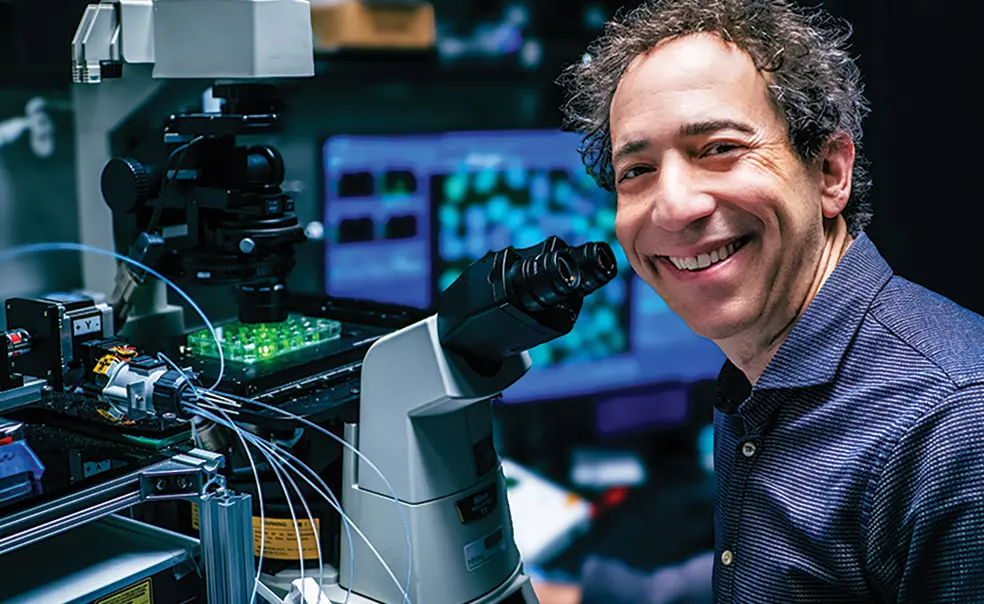Michael B. Elowitz *99 Researches How Cells Change Over Time
Elowitz focuses on advancing our understanding of RNA to cure diseases
When someone builds a computer from scratch, or codes a software program, they can better understand the system at their fingertips. The same theory applies to understanding the cells in our bodies, and for his entire career, Michael B. Elowitz *99 has been blazing a trail in synthetic biology to better analyze how cells change over time.
A professor of biological engineering at Caltech, Elowitz explains that if we want to program cells to cure disease, we have to understand their dynamic behaviors. “Cells can be dramatically transformed from one state to another, but this does not happen in a single step,” he says.
Elowitz has developed a methodology for reading RNA, which makes up the protein found in cells, without destroying a large amount of the cells themselves.
He notes that analyzing RNA does not absolutely require killing cells. Researchers can track the levels of an RNA of interest over time in single living cells, even within a developing embryo. But it’s currently possible for, at most, a few RNA species at a time, and it requires being able to directly view the RNA with a microscope, which is not possible in most organisms.
He says, “So, what’s impossible right now is to do this sort of thing at the scale required to understand the overall state of the cell and how it changes over time.”
When killing the cell, researchers can only capture a snapshot of the state of the cell the millisecond before it dies rather than being able to watch how it develops and changes over time.
What Elowitz and his lab created is “a new way to follow myriad cellular processes from embryonic development to cancer,” according to a press release from Caltech.
What does that mean for health care? Synthetic biology has enormous potential to expand therapeutic capabilities and create new therapeutic paradigms, Elowitz says, citing the example of gene therapy’s fundamental challenge.
He adds how his team recently developed a synthetic molecular circuit that ensures that each cell expresses the right amount of the gene no matter how many copies of the gene it receives. They found that this simple circuit could improve a Rett syndrome gene therapy in mice to counter the effect of the debilitating neurological disorder.
“Perhaps in the future we’ll be engineering cells to differentiate into other states and work together, because that’s how things work naturally.”
— Michael B. Elowitz *99
Elowitz tells PAW, “To track those dynamic changes over time, that would be amazing, because it would give you insight into which cells were doing what, how different cells were related to each other … and also give you insight into why certain cell populations might die.”
He adds that this method, co-led with his colleague Felix Horns, “could open a new window in a lot of biology that we didn’t have before.”
Elowitz, born in Los Angeles, has been winning acclaim for his molecular biology work since he earned his Ph.D. from Princeton in 1999. In 2007, he took home a MacArthur fellowship for his research into designing and testing artificial genetic circuits. At the time, his work was celebrated because he was able to show how it’s “possible to treat the cell as a programmable device.”
He likens this research to electronics. Simple electronic elements — transistors, capacitors, resistors, etc. — wired to one another in the right way can enable impressive functions. He asks, “Can one take simple molecular components — genes and proteins — and engineer their interactions to produce complex, but predictable, cellular behaviors?”
Cancer is one field Elowitz’s research can benefit. A synthetic circuit could assess a cell’s state, he explains, and classify it as tumorous or normal, and then conditionally kill it if and only if it is a tumor cell. This action would be hard to do with a conventional drug.
He finds it exciting to be part of a surging field of synthetic biology. “Researchers are trying to program cells to do a lot of useful things, such as having cells that can make chemical compounds very efficiently by putting in enzymes that transform into different kinds of useful molecules,” Elowitz says.
He adds that his lab seeks to create a foundation for programmable cell-based therapeutics and develop conceptual frameworks for understanding biological systems. Applying his research to the human body will require expanding from single-cell designs to multicellular systems, since we are made up of millions of cells that interact with one another.
“Perhaps in the future we’ll be engineering cells to differentiate into other states and work together, because that’s how things work naturally,” he says. “Our immune system is not based on one cell type, it’s not just a T-cell, it’s a whole bunch of T-cell types and B-cells that work together.”
Elowitz and his team have also developed a synthetic biology method called Memoir that can help them program a cell to record information in its own genome in a format that they can read out at the end. “And we can use that to reconstruct, for example, the lineage history of the cell,” he explains, “so if you see a bunch of cells, now we can see how all of them are related, and what was the last common ancestor of this group.”
Gene therapy is an area that instantly excites Elowitz, judging by how rapidly he speaks about this field of biology. He and his team have been working on a circuit module that can be inserted into a gene therapy and “give you a defined level, like produce a therapeutic protein at the right level irrespective of all the variability that can happen. That’s an example where a relatively simple circuit can maybe enhance the therapy, make it more predictable and accurate.”











No responses yet